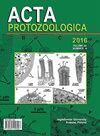盐沼变形虫对苔藓毯排水、再湿润及相关变化的响应——为期三年的中生态试验结果
IF 1.2
4区 生物学
Q4 MICROBIOLOGY
引用次数: 9
摘要
泥炭地是全球重要的碳库和碳汇,但这些功能受到持续气候变化的威胁。Testate变形虫是水文变化的有用生物指标,但关于地下水位变化对群落的影响,几乎没有实验工作。使用先前用于评估干旱干扰对群落和生态系统过程的影响的中尺度实验环境,使用三个对比的地下水位位置:湿润(-4 cm)、中等(-15 cm)和干燥(-25 cm),我们研究了当所有地块的地下水位保持在-10 cm时,种皮变形虫群落的恢复能力。整个实验持续了三年。我们评估了种皮变形虫群落的分类和功能性状反应。假设所选性状与水分含量(反应性状:外壳大小、孔径位置)或营养作用(影响性状:混合营养、孔径大小控制猎物范围)相关。在干扰阶段,混合营养物种凤蝶在湿地和中间地占主导地位,而群落在干地中转变为“干指示物”的主导地位(连翘、Nebela tincta、隐difflugia oviformis)和相应的性状(混合营养的丧失,以及具有腹侧或腹侧中心孔的较小分类群的主导地位)。在恢复阶段,我们在之前的湿润和中间地块中观察到了两种相反的趋势:泥炭藓地毯保持完整的群落保持相似,但泥炭藓退化的地块中干燥条件的物种和性状指标增加。在以前的旱地中,到实验结束时,湿润条件的指标和性状都有所增加。这是第一个模拟泥炭地非原位中尺度扰动和随后恢复的实验之一,重点研究了种皮变形虫群落结构以及功能特征对地下水位操纵的响应。结果普遍证实,测试变形虫在几个月内对水文变化做出反应,因此为评估泥炭地当前和过去的水文变化提供了有用的生物指标。本文章由计算机程序翻译,如有差异,请以英文原文为准。
Response of Sphagnum Testate Amoebae to Drainage, Subsequent Re-wetting and Associated Changes in the Moss Carpet – Results from a Three Year Mesocosm Experiment
Sphagnum peatlands represent a globally significant pool and sink of carbon but these functions are threatened by ongoing climate change. Testate amoebae are useful bioindicators of hydrological changes, but little experimental work has been done on the impact of water table changes on communities.
Using a mesocosm experimental setting that was previously used to assess the impact of drought disturbance on communities and ecosystem processes with three contrasted water table positions: wet (–4 cm), intermediate (–15 cm) and dry (–25 cm), we studied the capacity of testate amoeba communities to recover when the water table was kept at –10 cm for all plots. The overall experiment lasted three years. We assessed the taxonomic and functional trait responses of testate amoeba communities. The selected traits were hypothesised to be correlated to moisture content (response traits: shell size, aperture position) or trophic role (effect traits: mixotrophy, aperture size controlling prey range).
During the disturbance phase, the mixotrophic species Hyalosphenia papilio dominated the wet and intermediate plots, while the community shifted to a dominance of “dry indicators” (Corythion dubium, Nebela tincta, Cryptodifflugia oviformis) and corresponding traits (loss of mixotrophy, and dominance of smaller taxa with ventral or ventral-central aperture) in dry plots. During the recovery phase we observed two contrasted trends in the previously wet and intermediate plots: communities remained similar where the Sphagnum carpet remained intact but species and traits indicators of drier conditions increased in plots where it had degraded. In the former dry plots, indicators and traits of wet conditions increased by the end of the experiment.
This is one of the first experiment simulating a disturbance and subsequent recovery in ex-situ mesocosms of Sphagnum peatland focusing on the response of testate amoebae community structure as well as functional traits to water table manipulation. The results generally confirmed that testate amoebae respond within a few months to hydrological changes and thus represent useful bioindicators for assessing current and past hydrological changes in Sphagnum peatlands.
求助全文
通过发布文献求助,成功后即可免费获取论文全文。
去求助
来源期刊

Acta Protozoologica
生物-微生物学
CiteScore
2.00
自引率
0.00%
发文量
8
审稿时长
>12 weeks
期刊介绍:
Acta Protozoologica - International Journal on Protistology - is a quarterly journal that publishes current and comprehensive, experimental, and theoretical contributions across the breadth of protistology, and cell biology of Eukaryote microorganisms including: behaviour, biochemistry and molecular biology, development, ecology, genetics, parasitology, physiology, photobiology, systematics and phylogeny, and ultrastructure. It publishes original research reports, critical reviews of current research written by invited experts in the field, short communications, book reviews, and letters to the Editor.
 求助内容:
求助内容: 应助结果提醒方式:
应助结果提醒方式:


